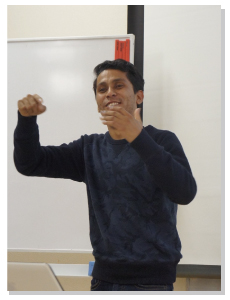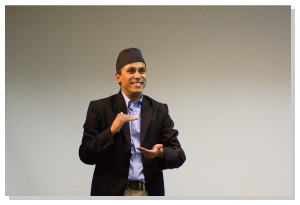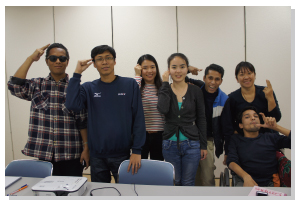- HOME
- Alumni News
- Gyan Bahadur BHITAKOTI (17th trainee)
- Gyan's Final Report
Gyan's Final Report
Final Report
To make Nepal a country where elderly people with disabilities can have fulfilling lives
1.My experiences in Japan
For the first three months after arriving in Japan, I studied Japanese and Japanese sign language. The written Japanese language comes in three forms: hiragana, katakana and kanji, which truly stunned me. It was very difficult to learn Japanese but I worked hard on it. Gradually I began to understand it. I also spent three months studying the Japanese sign language, and I am happy to say that I have mastered most of it. After the language training we were supposed to visit many different locations for our training programs, so I knew it was important to master the Japanese sign language, if I were to communicate properly with people and learn as much as possible from them. So I worked hard on my sign language.
Next, I will talk about our ski training. The six of us trainees have different disabilities, but we all enjoyed skiing. Especially unforgettable, was how people with visual impairment learned to ski. First the tips of the skis were secured together with a tool to help snow-plough. This way, it becomes easy to create the V triangle shape of snow ploughing. We all just look at our instructors’ skis, copy the angle of their triangles and adjust speed. But how about the trainees with visual impairment? How will they know the angle of the V shape? Cleverly, our instructors likened the V shape of the ski tips to a pizza slice and said “put your legs apart, the size of a pizza slice”, or “the size of two pizza slices”. We gradually got the sense of how to position our legs apart and learned to snow plough. When people get better, they can snow plough without the tool that keep the tips of the skis together. In the beginning I was using the tool but later on, I was able to snow plough without it. People told me I skied well, but I actually fell over about three times.
For my individual training, I went to Kagayaki Pasokon School to learn how to put subtitles to a video. In Nepal, once we shoot sign language videos, we upload them as are, online. The problem about this style is that, even though deaf people in Nepal can understand the sign language in the videos, people from other countries never will. But if this new method is adopted, it is impossible to release information to the world. What comes in handy, is subtitles. I learned that, if we put English subtitles to a video and upload it online, viewers can change that subtitle to the language of their choice and have the subtitles displayed in their own language. I would like to tell deaf people in Nepal such methods exist.
At NPO Japanese ASL Signers Society, I studied presentation techniques. While I was there, they gave me my first ever birthday celebration. In Nepal we do not celebrate birthdays and neither my parents nor my friends celebrated my birthday ever. The staff at Japanese ASL Signers Society had secretly planned to surprise me on my birthday. Suddenly a piece of pie came flying into my face. I was stunned. Not understanding what had happened, I wiped the cream around my eyes, and saw everyone saying “Happy birthday Gyan!” I was so happy. Afterwards a real cake was brought in, which we shared together. It was absolutely delicious. The birthday became an unforgettable memory.

2.Training in Japan
(1) The National Debate Meeting of Deaf Youth
The National Debate Meeting of Deaf Youth was held in Niigata Prefecture. As part of the program, there were smaller meetings for various issues and I chose to attend the meetings of a division for lifestyle. When I participated, I realized that Japan and Nepal had different ways of running such conventions. Nepal has a similar organization to the youth division and they organize all kinds of conventions and events, but the managers of deaf associations tend to assert their ideas and methods to young people, instead of helping young people voluntarily and proactively running such events and stating their opinions. In Japan, it was totally different. Young deaf people were sharing the issues they were facing in their everyday life, and they were trying to come up with solutions themselves. A director was attending the meeting from the board of Japanese Federation of the Deaf as an advisor, but he was there only to give advice. I would like to think of ways in Nepal where young people can take part in activities proactively like this. It will not go smoothly from the start, but I feel it will eventually work if we work on it step by step. Going forward, I would like to take on the role to support young deaf people in Nepal, as I have been given such invaluable experiences in Japan,

(2) Awaji Fukuro No Sato
I attended a training program at Awaji Fukuro No Sato, a geriatric home for elderly deaf people. The elderly deaf people there told me stories of their lives, including the hardships they had gone through, in great detail. It was such a learning experience for me. At first I was just an observer, but I wanted to know more about their lives and participated in the program to experience daily help service. I noticed it was not always female assistants who helped female residents bathe. If the service user was heavy, male assistants came in to help because female assistants alone could not help the user. Help methods also varies, to match the various needs of each user. The members of the staff had various special skills to support the lives of the residents.
(3) Tajima Center for the Deaf
Next, I went to Tajima Center for the Deaf in Toyooka City, to learn how to support elderly deaf people and deaf people with other disabilities. Some elderly deaf people start working at a young age, but have nothing to do once they retire and confine themselves to their homes. If they live alone and keep the sorrow and stress to themselves they will become ill, so they need a place where they can get together with other elderly deaf people. This center was there to make that possible. Elderly deaf people engaged in easy tasks or interacted with each other to exchange information. The center also provided some health management service, like measuring their blood pressure.
3.My goals after returning to Nepal
First, I want to create a community for elderly deaf people. It is important for young people and elderly people to interact with each other, but there is a gap in their thinking and lifestyles, so I feel it is also important to create a place designated to elderly people, where they can be together and communicate fully with each other.
Second, I would like to create opportunities for elderly people to enjoy themselves. They can engage in easy tasks or draw sketches and paintings. I would like to plan a variety of such events to create learning programs and entertainment opportunities for elderly deaf people.
Next, the association of the deaf in Nepal has divisions for women, youth and sports, but not for the elderly. I would really like to establish a division for them and make it a system where elderly deaf people can develop their own activities. Also in Nepal, there are associations for different provinces but not for cities, towns or villages, so I would like to establish these smaller associations. Nepal does not have adequate public transport system, so it is hard for deaf people to travel far. If there is a deaf association in their own town or village, they can exchange information with others more easily, interact with others and enroll in all kinds of activities and sports. They can then visit larger prefectural or national deaf associations once or twice a year.
Finally, I would like to eradicate discrimination and prejudice against deaf people. The important thing is to have more sign language interpreters. It is important for deaf people to work with sign language interpreters, as they will be our voice and ears when we negotiate with government authorities and help society deepen their understanding of deaf people.
I will tell my friends and peers in Nepal about what I learned in Japan, but that will not be the end. We need to have the same standpoint and continue with our activities, helping each other.
4. Words of gratitude
Last but not the least, I would like to express my heartfelt thanks to everyone at Duskin AINOWA Foundation, my training locations, and Japanese Society for Rehabilitation of Persons with Disabilities. Thank you so much.





